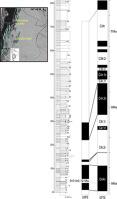Cecilia M. Spagnuolo, Sergio M. Georgieff, Augusto E. Rapalini
2 015
Journal of South American Earth Sciences 63: 101-113
The first magnetostratigraphic study of the Las Arcas Formation (Late Miocene) was carried out in Las Totoritas creek (26º120S; 65º470W, NW Argentina), a key place in between of two geological provinces: Northwestern Pampean Ranges and Eastern Cordillera, in northwestern Argentina. This was accompanied by isotopic dating (9.01 ± 0.12 Ma, 40Ar/39Ar in amphibole) of the unit, obtained from a 3.4 m thick tuff intercalated at ~45 m above the base. The Las Arcas Formation is 810 m thick at the sampling locality and it is mainly composed of tabular reddish conglomerates, sandstones and siltstones in both coarsening-and thickening-upward arrangements. The exposed section was sampled at 48 sites, 26 of which are interpreted as carrying primary magnetization. The new magnetostratigraphic column was correlated with the Geomagnetic Polarity Time Scale (GPTS), and suggests that deposition of the Las Arcas Formation strata started at around 9.1 Ma and ended around 6.8 Ma. The paleomagnetic pole obtained for this unit (Dec = 8.7°, Inc = 43.9°, dp =14.9°, dm= 9.3°) indicates that this area underwent nonsignificant rotation (11.0° ± 13.6°) since the Late Miocene.

